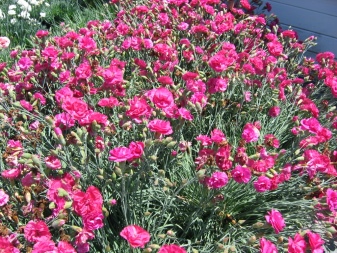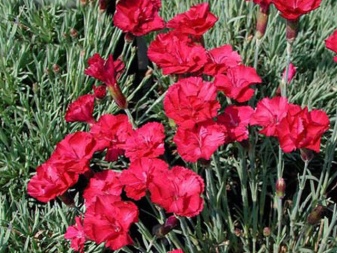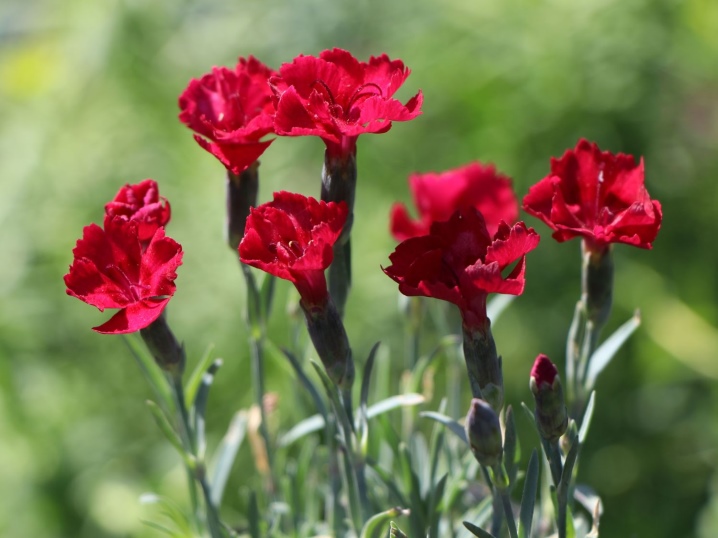Blue carnation: description, varieties, recommendations for growing

Since ancient times, the carnation has been a very popular plant all over the world. The name is translated from ancient Greek as "flower of the gods". In European countries, carnation flowers are considered a symbol of courage. In total, there are more than 500 varieties, but in the middle lane, the most common are grayish-blue carnations, varieties "Badenia", "Bombardir" and "Rubin".

Herbaceous perennial
The gray carnation, better known as the grayish blue carnation, is an excellent option for the garden. Loves sunlight and warmth, resistant to winter cold. It grows mainly between stones on uneven terrain in arid soil. Shoots with a lot of foliage can reach 20–25 cm in length.


Perennial has 2 types of stems:
- vegetative - grayish-green or gray-bluish, densely branching at the base;
- flowering - slender erect with a flower.
Carnation flowers are very fragrant, most often single, with a diameter of 1.5–2.5 cm. A wide palette of color shades will surprise every gardener. The most common color is pink, and there are also shades of red and white. The leaves are rough, hard and almost flat, bluish-gray in color.



The plant will easily fit into any landscape and will look good even in a non-flowering state.
Blue-gray carnation blooms in the warm season, in summer. A favorable environment is both a hot climate, aridity and lack of moisture in the soil, as well as cold weather conditions. The main advantage of a carnation is its unpretentiousness, caring for it is very simple. Watering is required only in very arid soil, frost-resistant, loves the sun, but can grow in partial shade.

Very often, blue-gray carnation is used in landscape design. A perennial plant will look advantageous among rocky terrain, curbs, on an alpine hill.
Basically, it is planted in groups to replace the lawn, since it spreads densely over the soil and retains its decorative effect even outside the flowering time.


Description of varieties
Today there is more than 300 types of carnation varieties, differing in flowering time, color, petal shape and stem height.
- The birthplace of the carnation varieties "Badenia" considered Northern Europe, where the plant is found in rocky mountainous areas. The Latin name of the variety is Dianthus gratianopolitanus Badenia. "Badenia" is a perennial plant that spreads over the soil in a dense pillow, gray-blue foliage is flat and tough. Flowers are presented in various shades of pink, most often saturated colors, and the edges of the petals can be jagged. The conditions of a warm arid climate are favorable for Badenia carnations, but the plant will feel good in the shade. Blooms mainly in summer, starting in July. Duration of flowering is about a month, but since the carnation is a perennial plant, "Badenia" can decorate the garden for about 3 years.


- Carnation grayish blue varieties "Bombardir" differs in small fragrant bright flowers. The Latin name for this variety is Dianthus gratianopolitanus Bombardier. A perennial plant with bluish-bluish long and narrow leaves has weak vegetative stems. The height of the Bombardir carnation is about 15 cm, and during the flowering period it reaches 20–25, about 60 cm wide. It blooms from May for a little more than a month. "Bombardier" has bright fragrant flowers of all shades of pink and red, double petals.Unlike other varieties of cloves, "Bombardir" is very resistant to frost, does not require special care even at very low negative temperatures.


- "Ruby" - a special kind of perennial blue-gray carnation. The Latin name is Dianthus gratianopolitanus Rubin. It got its name from the bright saturated color of the buds. The flowers have a strong, pleasant aroma. A dense cushion of a large number of vegetative shoots forms at the base of the perennial plant. The flowering period is from early spring to late summer. The height of an adult plant during the flowering period reaches 25 cm, width 45-60.

The Rubin variety is very thermophilic and loves the sun, will not grow on wet heavy soil.
- Carnation variety "Rotkappchen" also belongs to the group of perennial plants. The name is translated into Russian as "Little Red Riding Hood". Blooms from June to August. Unlike other varieties of this plant, "Rotkappchen" has small buds of red, pink and their shades, collected in inflorescences. The leaves are long, rough, grayish-blue.

- Pink Jewel variety got its name from the amazing beauty of small flowers, similar to a scattering of diamonds. The name is translated into Russian as "pink gem". The flowers are fragrant, the leaves of the buds are serrated, terry. The bushes of a perennial plant reach a height of 20 cm. "Pink Jewel" does not tolerate waterlogged soil, on the contrary, it loves direct sunlight.


- It is very unpretentious grenoble carnation... The variety owes its name to the country of origin. Has a pronounced clove sweet aroma. It grows evenly and compactly, resistant to frost and drought. It goes well with other cultures.

Planting, care and reproduction
The main advantage and convenience of all varieties of grayish-blue carnations is its simplicity and ease of care. The best results will be obtained by planting a perennial plant in spring or early summer in well-moisturized soil in direct sunlight. The optimum temperature for keeping cloves is about 15–20 ° C.
It is important to remember about the moisture content of the soil and water it only during dry periods, otherwise the roots will begin to rot.
A carnation needs special care during the transplant period. Spring is considered the best time to change location.
Sowing seeds should be at a depth of no more than 2 cm and at a sufficient distance from each other. So that other bushes do not interfere with the growth of the perennial, it is better to leave about 20 cm between them. To speed up the germination process, you can cover the planting site with glass or film.

Reproduction of carnations is possible in 2 ways:
- layering;
- reproduction of the bush.

Reproduction by layering is easier and does not require time-consuming. The extreme branches of the plant are covered with earth. For better growth, you can trim the leaves from a sprinkled branch. The best time for propagation by layering is early spring. For reproduction, a flowering bush is dug out, the roots are cut and the bush settles in a new place. At first, the plant will require abundant watering, and after 8-10 days it grows well in width.
Blue-gray carnation prefers light, slightly alkaline, not waterlogged soil. The plant has good frost resistance and does not require shelter from the winter cold in the middle lane.
It is an excellent choice for decorating an alpine slide or planting along the curbs in the garden.



The view is popular among amateur gardeners, since caring for it is very simple, and the results of flowering will delight the eye for a long time.
For all about caring for a blue carnation, see the next video.







































































































The comment was sent successfully.